Leadership and Operations: A Comprehensive Report - Unit 4
VerifiedAdded on 2023/01/06
|14
|4497
|40
Report
AI Summary
This report explores the concepts of management and operations, focusing on the roles and characteristics of leaders and managers within an organization. It differentiates between the functions of a manager and the role of a leader, emphasizing their impact on achieving organizational goals. The report analyzes how leadership and management theories, including situational, systems, and contingency theories, can be applied in various contexts, such as recruitment, change management, and performance management. It also evaluates the strengths and weaknesses of these approaches within the work environment and explains the key approaches to operations management, including Total Quality Management (TQM). Furthermore, the report examines factors within the business environment that affect operational management and emphasizes the importance and value of operations management in achieving business objectives.
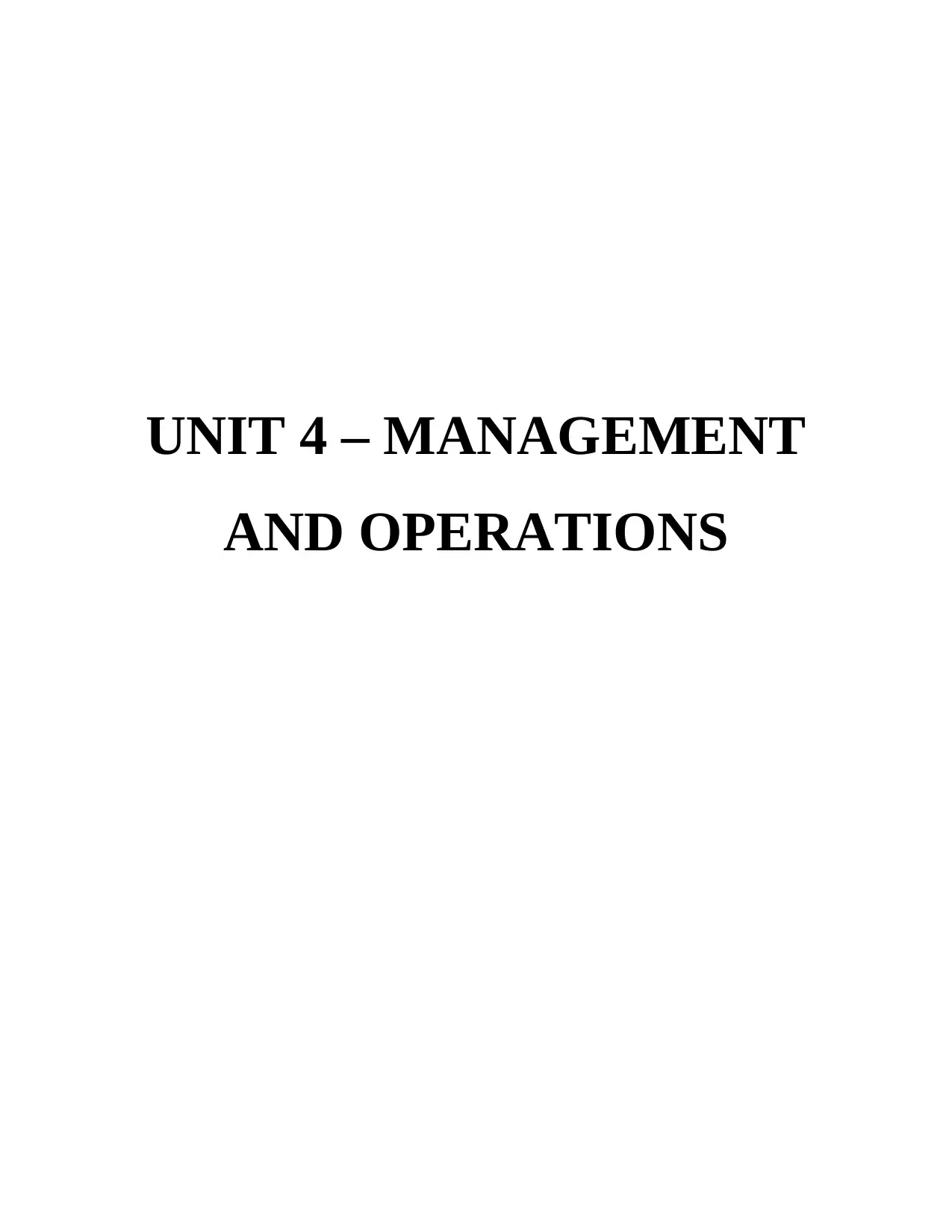
UNIT 4 – MANAGEMENT
AND OPERATIONS
AND OPERATIONS
Paraphrase This Document
Need a fresh take? Get an instant paraphrase of this document with our AI Paraphraser
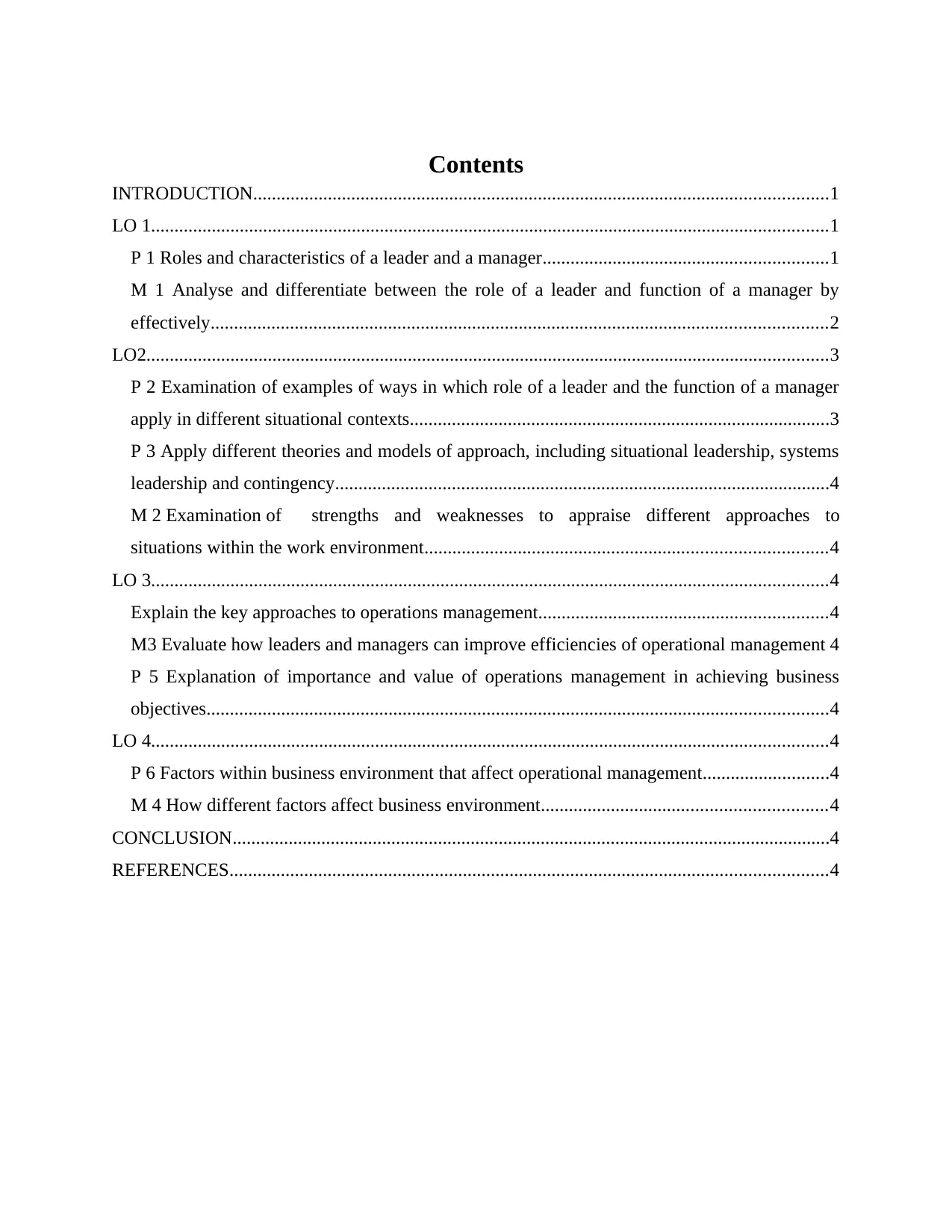
Contents
INTRODUCTION...........................................................................................................................1
LO 1.................................................................................................................................................1
P 1 Roles and characteristics of a leader and a manager.............................................................1
M 1 Analyse and differentiate between the role of a leader and function of a manager by
effectively....................................................................................................................................2
LO2..................................................................................................................................................3
P 2 Examination of examples of ways in which role of a leader and the function of a manager
apply in different situational contexts..........................................................................................3
P 3 Apply different theories and models of approach, including situational leadership, systems
leadership and contingency..........................................................................................................4
M 2 Examination of strengths and weaknesses to appraise different approaches to
situations within the work environment......................................................................................4
LO 3.................................................................................................................................................4
Explain the key approaches to operations management..............................................................4
M3 Evaluate how leaders and managers can improve efficiencies of operational management 4
P 5 Explanation of importance and value of operations management in achieving business
objectives.....................................................................................................................................4
LO 4.................................................................................................................................................4
P 6 Factors within business environment that affect operational management...........................4
M 4 How different factors affect business environment.............................................................4
CONCLUSION................................................................................................................................4
REFERENCES................................................................................................................................4
INTRODUCTION...........................................................................................................................1
LO 1.................................................................................................................................................1
P 1 Roles and characteristics of a leader and a manager.............................................................1
M 1 Analyse and differentiate between the role of a leader and function of a manager by
effectively....................................................................................................................................2
LO2..................................................................................................................................................3
P 2 Examination of examples of ways in which role of a leader and the function of a manager
apply in different situational contexts..........................................................................................3
P 3 Apply different theories and models of approach, including situational leadership, systems
leadership and contingency..........................................................................................................4
M 2 Examination of strengths and weaknesses to appraise different approaches to
situations within the work environment......................................................................................4
LO 3.................................................................................................................................................4
Explain the key approaches to operations management..............................................................4
M3 Evaluate how leaders and managers can improve efficiencies of operational management 4
P 5 Explanation of importance and value of operations management in achieving business
objectives.....................................................................................................................................4
LO 4.................................................................................................................................................4
P 6 Factors within business environment that affect operational management...........................4
M 4 How different factors affect business environment.............................................................4
CONCLUSION................................................................................................................................4
REFERENCES................................................................................................................................4
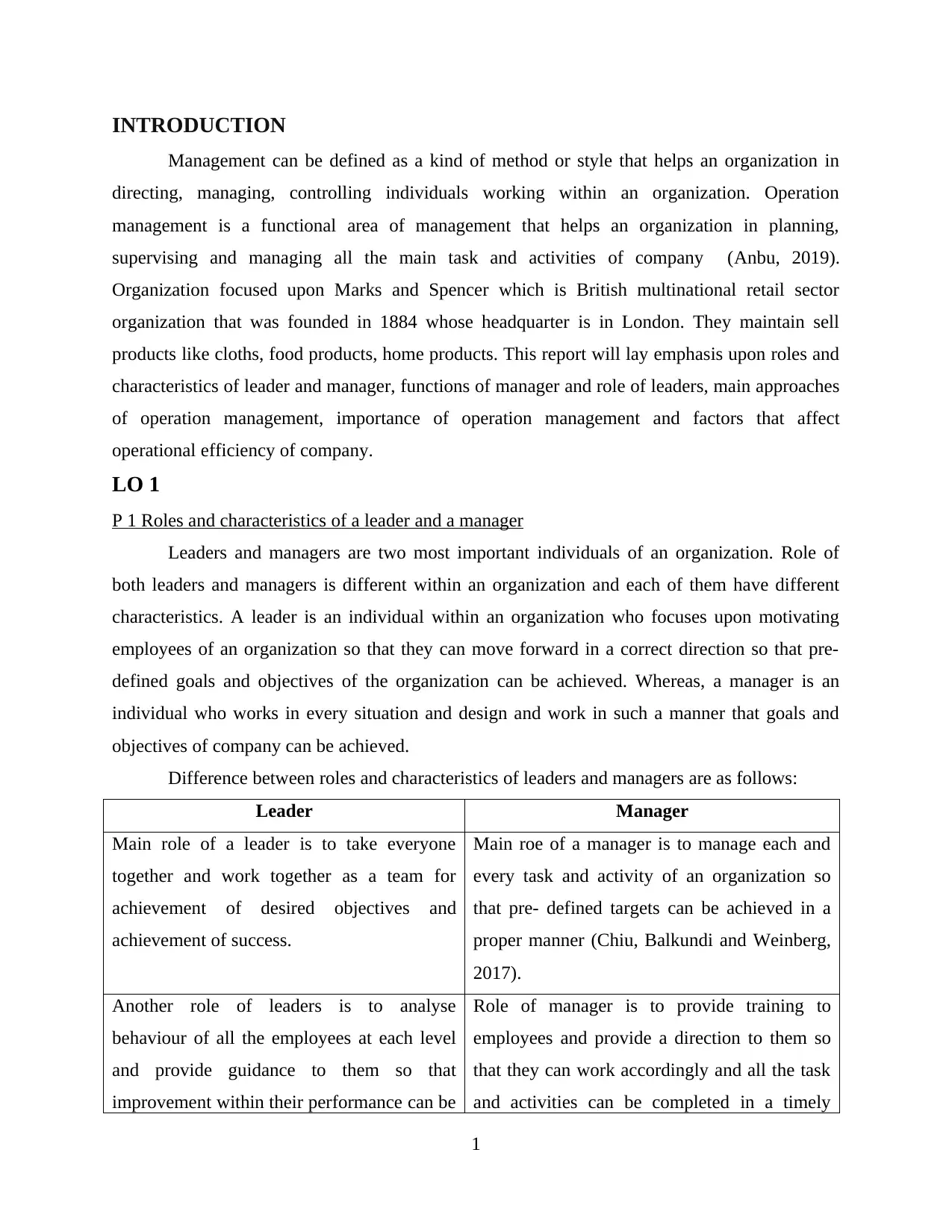
INTRODUCTION
Management can be defined as a kind of method or style that helps an organization in
directing, managing, controlling individuals working within an organization. Operation
management is a functional area of management that helps an organization in planning,
supervising and managing all the main task and activities of company (Anbu, 2019).
Organization focused upon Marks and Spencer which is British multinational retail sector
organization that was founded in 1884 whose headquarter is in London. They maintain sell
products like cloths, food products, home products. This report will lay emphasis upon roles and
characteristics of leader and manager, functions of manager and role of leaders, main approaches
of operation management, importance of operation management and factors that affect
operational efficiency of company.
LO 1
P 1 Roles and characteristics of a leader and a manager
Leaders and managers are two most important individuals of an organization. Role of
both leaders and managers is different within an organization and each of them have different
characteristics. A leader is an individual within an organization who focuses upon motivating
employees of an organization so that they can move forward in a correct direction so that pre-
defined goals and objectives of the organization can be achieved. Whereas, a manager is an
individual who works in every situation and design and work in such a manner that goals and
objectives of company can be achieved.
Difference between roles and characteristics of leaders and managers are as follows:
Leader Manager
Main role of a leader is to take everyone
together and work together as a team for
achievement of desired objectives and
achievement of success.
Main roe of a manager is to manage each and
every task and activity of an organization so
that pre- defined targets can be achieved in a
proper manner (Chiu, Balkundi and Weinberg,
2017).
Another role of leaders is to analyse
behaviour of all the employees at each level
and provide guidance to them so that
improvement within their performance can be
Role of manager is to provide training to
employees and provide a direction to them so
that they can work accordingly and all the task
and activities can be completed in a timely
1
Management can be defined as a kind of method or style that helps an organization in
directing, managing, controlling individuals working within an organization. Operation
management is a functional area of management that helps an organization in planning,
supervising and managing all the main task and activities of company (Anbu, 2019).
Organization focused upon Marks and Spencer which is British multinational retail sector
organization that was founded in 1884 whose headquarter is in London. They maintain sell
products like cloths, food products, home products. This report will lay emphasis upon roles and
characteristics of leader and manager, functions of manager and role of leaders, main approaches
of operation management, importance of operation management and factors that affect
operational efficiency of company.
LO 1
P 1 Roles and characteristics of a leader and a manager
Leaders and managers are two most important individuals of an organization. Role of
both leaders and managers is different within an organization and each of them have different
characteristics. A leader is an individual within an organization who focuses upon motivating
employees of an organization so that they can move forward in a correct direction so that pre-
defined goals and objectives of the organization can be achieved. Whereas, a manager is an
individual who works in every situation and design and work in such a manner that goals and
objectives of company can be achieved.
Difference between roles and characteristics of leaders and managers are as follows:
Leader Manager
Main role of a leader is to take everyone
together and work together as a team for
achievement of desired objectives and
achievement of success.
Main roe of a manager is to manage each and
every task and activity of an organization so
that pre- defined targets can be achieved in a
proper manner (Chiu, Balkundi and Weinberg,
2017).
Another role of leaders is to analyse
behaviour of all the employees at each level
and provide guidance to them so that
improvement within their performance can be
Role of manager is to provide training to
employees and provide a direction to them so
that they can work accordingly and all the task
and activities can be completed in a timely
1
⊘ This is a preview!⊘
Do you want full access?
Subscribe today to unlock all pages.

Trusted by 1+ million students worldwide
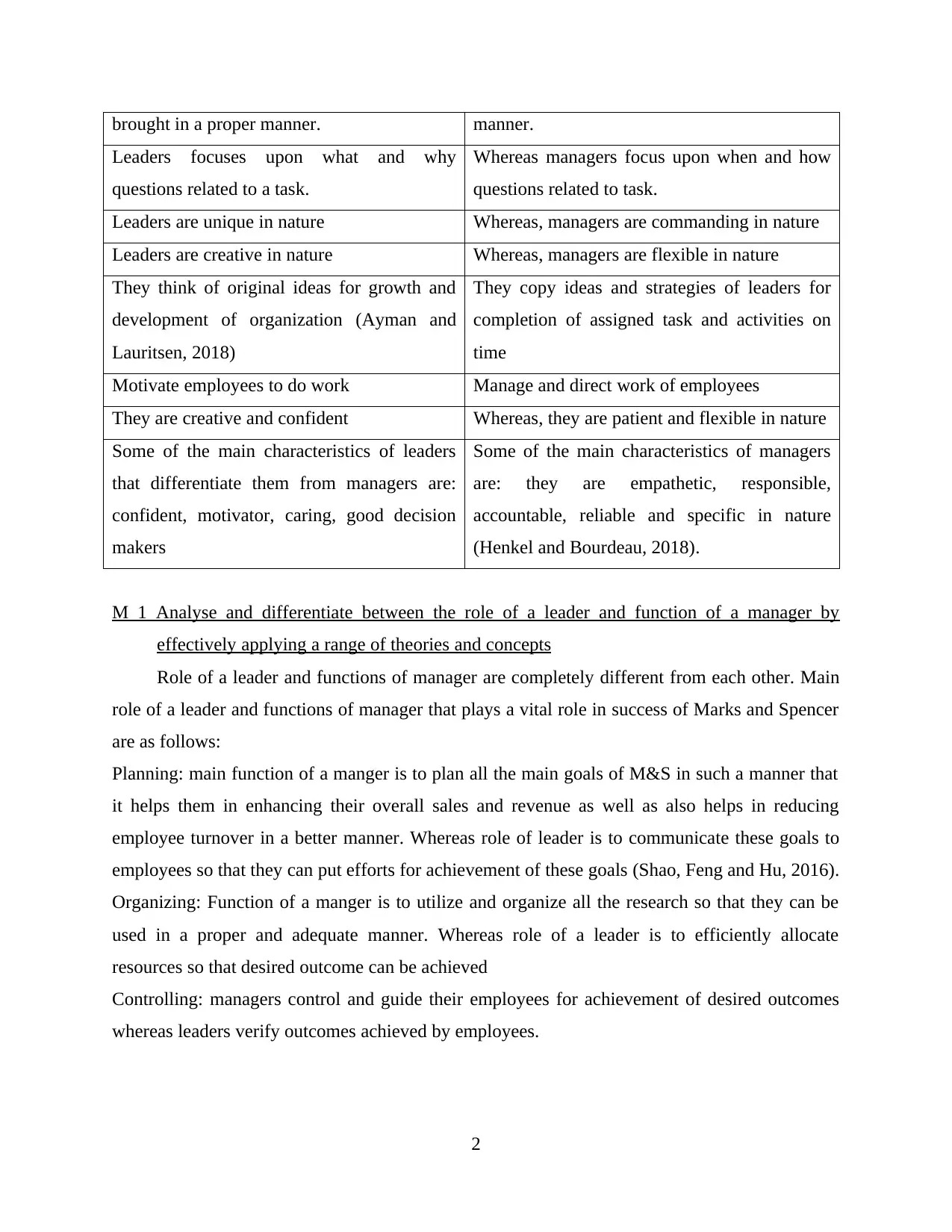
brought in a proper manner. manner.
Leaders focuses upon what and why
questions related to a task.
Whereas managers focus upon when and how
questions related to task.
Leaders are unique in nature Whereas, managers are commanding in nature
Leaders are creative in nature Whereas, managers are flexible in nature
They think of original ideas for growth and
development of organization (Ayman and
Lauritsen, 2018)
They copy ideas and strategies of leaders for
completion of assigned task and activities on
time
Motivate employees to do work Manage and direct work of employees
They are creative and confident Whereas, they are patient and flexible in nature
Some of the main characteristics of leaders
that differentiate them from managers are:
confident, motivator, caring, good decision
makers
Some of the main characteristics of managers
are: they are empathetic, responsible,
accountable, reliable and specific in nature
(Henkel and Bourdeau, 2018).
M 1 Analyse and differentiate between the role of a leader and function of a manager by
effectively applying a range of theories and concepts
Role of a leader and functions of manager are completely different from each other. Main
role of a leader and functions of manager that plays a vital role in success of Marks and Spencer
are as follows:
Planning: main function of a manger is to plan all the main goals of M&S in such a manner that
it helps them in enhancing their overall sales and revenue as well as also helps in reducing
employee turnover in a better manner. Whereas role of leader is to communicate these goals to
employees so that they can put efforts for achievement of these goals (Shao, Feng and Hu, 2016).
Organizing: Function of a manger is to utilize and organize all the research so that they can be
used in a proper and adequate manner. Whereas role of a leader is to efficiently allocate
resources so that desired outcome can be achieved
Controlling: managers control and guide their employees for achievement of desired outcomes
whereas leaders verify outcomes achieved by employees.
2
Leaders focuses upon what and why
questions related to a task.
Whereas managers focus upon when and how
questions related to task.
Leaders are unique in nature Whereas, managers are commanding in nature
Leaders are creative in nature Whereas, managers are flexible in nature
They think of original ideas for growth and
development of organization (Ayman and
Lauritsen, 2018)
They copy ideas and strategies of leaders for
completion of assigned task and activities on
time
Motivate employees to do work Manage and direct work of employees
They are creative and confident Whereas, they are patient and flexible in nature
Some of the main characteristics of leaders
that differentiate them from managers are:
confident, motivator, caring, good decision
makers
Some of the main characteristics of managers
are: they are empathetic, responsible,
accountable, reliable and specific in nature
(Henkel and Bourdeau, 2018).
M 1 Analyse and differentiate between the role of a leader and function of a manager by
effectively applying a range of theories and concepts
Role of a leader and functions of manager are completely different from each other. Main
role of a leader and functions of manager that plays a vital role in success of Marks and Spencer
are as follows:
Planning: main function of a manger is to plan all the main goals of M&S in such a manner that
it helps them in enhancing their overall sales and revenue as well as also helps in reducing
employee turnover in a better manner. Whereas role of leader is to communicate these goals to
employees so that they can put efforts for achievement of these goals (Shao, Feng and Hu, 2016).
Organizing: Function of a manger is to utilize and organize all the research so that they can be
used in a proper and adequate manner. Whereas role of a leader is to efficiently allocate
resources so that desired outcome can be achieved
Controlling: managers control and guide their employees for achievement of desired outcomes
whereas leaders verify outcomes achieved by employees.
2
Paraphrase This Document
Need a fresh take? Get an instant paraphrase of this document with our AI Paraphraser
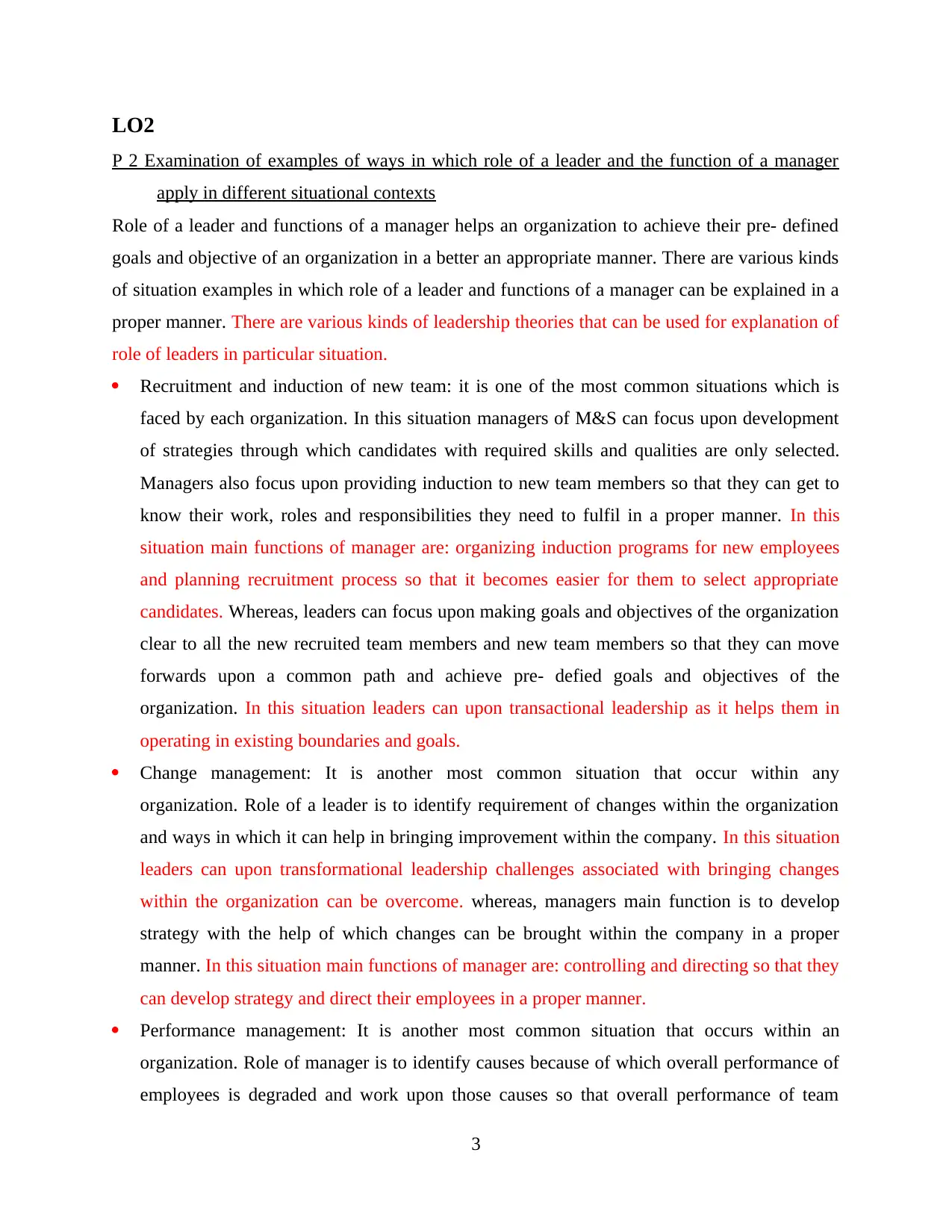
LO2
P 2 Examination of examples of ways in which role of a leader and the function of a manager
apply in different situational contexts
Role of a leader and functions of a manager helps an organization to achieve their pre- defined
goals and objective of an organization in a better an appropriate manner. There are various kinds
of situation examples in which role of a leader and functions of a manager can be explained in a
proper manner. There are various kinds of leadership theories that can be used for explanation of
role of leaders in particular situation.
Recruitment and induction of new team: it is one of the most common situations which is
faced by each organization. In this situation managers of M&S can focus upon development
of strategies through which candidates with required skills and qualities are only selected.
Managers also focus upon providing induction to new team members so that they can get to
know their work, roles and responsibilities they need to fulfil in a proper manner. In this
situation main functions of manager are: organizing induction programs for new employees
and planning recruitment process so that it becomes easier for them to select appropriate
candidates. Whereas, leaders can focus upon making goals and objectives of the organization
clear to all the new recruited team members and new team members so that they can move
forwards upon a common path and achieve pre- defied goals and objectives of the
organization. In this situation leaders can upon transactional leadership as it helps them in
operating in existing boundaries and goals.
Change management: It is another most common situation that occur within any
organization. Role of a leader is to identify requirement of changes within the organization
and ways in which it can help in bringing improvement within the company. In this situation
leaders can upon transformational leadership challenges associated with bringing changes
within the organization can be overcome. whereas, managers main function is to develop
strategy with the help of which changes can be brought within the company in a proper
manner. In this situation main functions of manager are: controlling and directing so that they
can develop strategy and direct their employees in a proper manner.
Performance management: It is another most common situation that occurs within an
organization. Role of manager is to identify causes because of which overall performance of
employees is degraded and work upon those causes so that overall performance of team
3
P 2 Examination of examples of ways in which role of a leader and the function of a manager
apply in different situational contexts
Role of a leader and functions of a manager helps an organization to achieve their pre- defined
goals and objective of an organization in a better an appropriate manner. There are various kinds
of situation examples in which role of a leader and functions of a manager can be explained in a
proper manner. There are various kinds of leadership theories that can be used for explanation of
role of leaders in particular situation.
Recruitment and induction of new team: it is one of the most common situations which is
faced by each organization. In this situation managers of M&S can focus upon development
of strategies through which candidates with required skills and qualities are only selected.
Managers also focus upon providing induction to new team members so that they can get to
know their work, roles and responsibilities they need to fulfil in a proper manner. In this
situation main functions of manager are: organizing induction programs for new employees
and planning recruitment process so that it becomes easier for them to select appropriate
candidates. Whereas, leaders can focus upon making goals and objectives of the organization
clear to all the new recruited team members and new team members so that they can move
forwards upon a common path and achieve pre- defied goals and objectives of the
organization. In this situation leaders can upon transactional leadership as it helps them in
operating in existing boundaries and goals.
Change management: It is another most common situation that occur within any
organization. Role of a leader is to identify requirement of changes within the organization
and ways in which it can help in bringing improvement within the company. In this situation
leaders can upon transformational leadership challenges associated with bringing changes
within the organization can be overcome. whereas, managers main function is to develop
strategy with the help of which changes can be brought within the company in a proper
manner. In this situation main functions of manager are: controlling and directing so that they
can develop strategy and direct their employees in a proper manner.
Performance management: It is another most common situation that occurs within an
organization. Role of manager is to identify causes because of which overall performance of
employees is degraded and work upon those causes so that overall performance of team
3
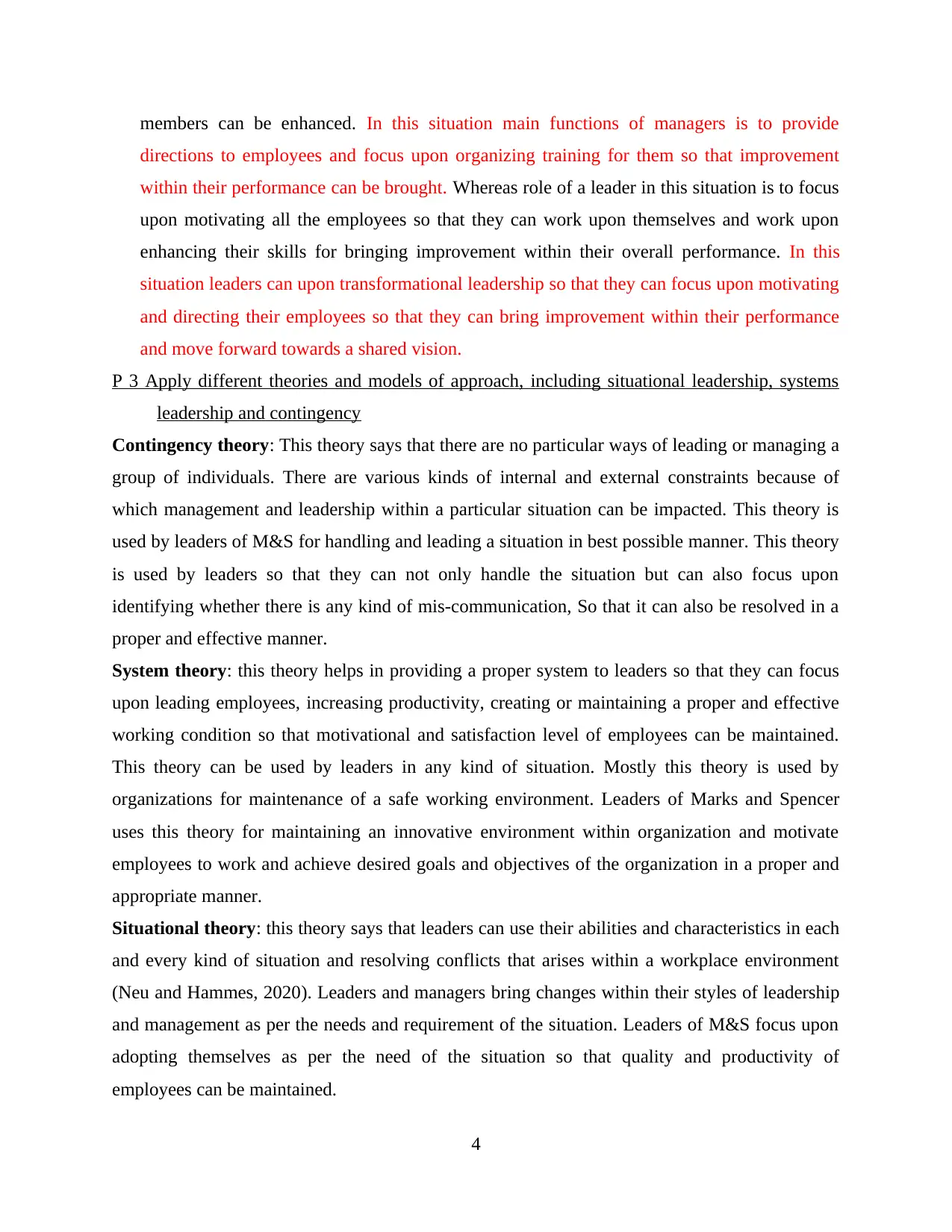
members can be enhanced. In this situation main functions of managers is to provide
directions to employees and focus upon organizing training for them so that improvement
within their performance can be brought. Whereas role of a leader in this situation is to focus
upon motivating all the employees so that they can work upon themselves and work upon
enhancing their skills for bringing improvement within their overall performance. In this
situation leaders can upon transformational leadership so that they can focus upon motivating
and directing their employees so that they can bring improvement within their performance
and move forward towards a shared vision.
P 3 Apply different theories and models of approach, including situational leadership, systems
leadership and contingency
Contingency theory: This theory says that there are no particular ways of leading or managing a
group of individuals. There are various kinds of internal and external constraints because of
which management and leadership within a particular situation can be impacted. This theory is
used by leaders of M&S for handling and leading a situation in best possible manner. This theory
is used by leaders so that they can not only handle the situation but can also focus upon
identifying whether there is any kind of mis-communication, So that it can also be resolved in a
proper and effective manner.
System theory: this theory helps in providing a proper system to leaders so that they can focus
upon leading employees, increasing productivity, creating or maintaining a proper and effective
working condition so that motivational and satisfaction level of employees can be maintained.
This theory can be used by leaders in any kind of situation. Mostly this theory is used by
organizations for maintenance of a safe working environment. Leaders of Marks and Spencer
uses this theory for maintaining an innovative environment within organization and motivate
employees to work and achieve desired goals and objectives of the organization in a proper and
appropriate manner.
Situational theory: this theory says that leaders can use their abilities and characteristics in each
and every kind of situation and resolving conflicts that arises within a workplace environment
(Neu and Hammes, 2020). Leaders and managers bring changes within their styles of leadership
and management as per the needs and requirement of the situation. Leaders of M&S focus upon
adopting themselves as per the need of the situation so that quality and productivity of
employees can be maintained.
4
directions to employees and focus upon organizing training for them so that improvement
within their performance can be brought. Whereas role of a leader in this situation is to focus
upon motivating all the employees so that they can work upon themselves and work upon
enhancing their skills for bringing improvement within their overall performance. In this
situation leaders can upon transformational leadership so that they can focus upon motivating
and directing their employees so that they can bring improvement within their performance
and move forward towards a shared vision.
P 3 Apply different theories and models of approach, including situational leadership, systems
leadership and contingency
Contingency theory: This theory says that there are no particular ways of leading or managing a
group of individuals. There are various kinds of internal and external constraints because of
which management and leadership within a particular situation can be impacted. This theory is
used by leaders of M&S for handling and leading a situation in best possible manner. This theory
is used by leaders so that they can not only handle the situation but can also focus upon
identifying whether there is any kind of mis-communication, So that it can also be resolved in a
proper and effective manner.
System theory: this theory helps in providing a proper system to leaders so that they can focus
upon leading employees, increasing productivity, creating or maintaining a proper and effective
working condition so that motivational and satisfaction level of employees can be maintained.
This theory can be used by leaders in any kind of situation. Mostly this theory is used by
organizations for maintenance of a safe working environment. Leaders of Marks and Spencer
uses this theory for maintaining an innovative environment within organization and motivate
employees to work and achieve desired goals and objectives of the organization in a proper and
appropriate manner.
Situational theory: this theory says that leaders can use their abilities and characteristics in each
and every kind of situation and resolving conflicts that arises within a workplace environment
(Neu and Hammes, 2020). Leaders and managers bring changes within their styles of leadership
and management as per the needs and requirement of the situation. Leaders of M&S focus upon
adopting themselves as per the need of the situation so that quality and productivity of
employees can be maintained.
4
⊘ This is a preview!⊘
Do you want full access?
Subscribe today to unlock all pages.

Trusted by 1+ million students worldwide
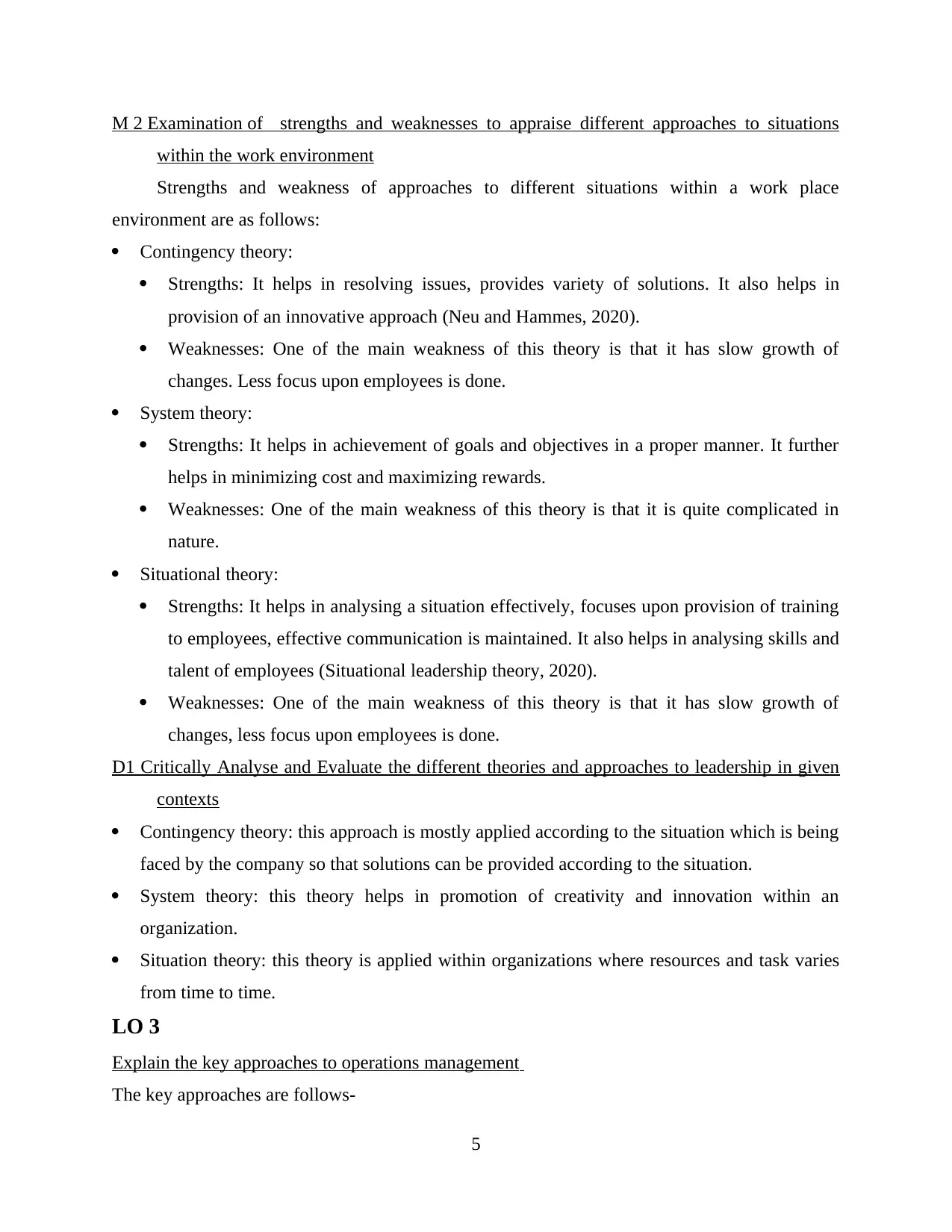
M 2 Examination of strengths and weaknesses to appraise different approaches to situations
within the work environment
Strengths and weakness of approaches to different situations within a work place
environment are as follows:
Contingency theory:
Strengths: It helps in resolving issues, provides variety of solutions. It also helps in
provision of an innovative approach (Neu and Hammes, 2020).
Weaknesses: One of the main weakness of this theory is that it has slow growth of
changes. Less focus upon employees is done.
System theory:
Strengths: It helps in achievement of goals and objectives in a proper manner. It further
helps in minimizing cost and maximizing rewards.
Weaknesses: One of the main weakness of this theory is that it is quite complicated in
nature.
Situational theory:
Strengths: It helps in analysing a situation effectively, focuses upon provision of training
to employees, effective communication is maintained. It also helps in analysing skills and
talent of employees (Situational leadership theory, 2020).
Weaknesses: One of the main weakness of this theory is that it has slow growth of
changes, less focus upon employees is done.
D1 Critically Analyse and Evaluate the different theories and approaches to leadership in given
contexts
Contingency theory: this approach is mostly applied according to the situation which is being
faced by the company so that solutions can be provided according to the situation.
System theory: this theory helps in promotion of creativity and innovation within an
organization.
Situation theory: this theory is applied within organizations where resources and task varies
from time to time.
LO 3
Explain the key approaches to operations management
The key approaches are follows-
5
within the work environment
Strengths and weakness of approaches to different situations within a work place
environment are as follows:
Contingency theory:
Strengths: It helps in resolving issues, provides variety of solutions. It also helps in
provision of an innovative approach (Neu and Hammes, 2020).
Weaknesses: One of the main weakness of this theory is that it has slow growth of
changes. Less focus upon employees is done.
System theory:
Strengths: It helps in achievement of goals and objectives in a proper manner. It further
helps in minimizing cost and maximizing rewards.
Weaknesses: One of the main weakness of this theory is that it is quite complicated in
nature.
Situational theory:
Strengths: It helps in analysing a situation effectively, focuses upon provision of training
to employees, effective communication is maintained. It also helps in analysing skills and
talent of employees (Situational leadership theory, 2020).
Weaknesses: One of the main weakness of this theory is that it has slow growth of
changes, less focus upon employees is done.
D1 Critically Analyse and Evaluate the different theories and approaches to leadership in given
contexts
Contingency theory: this approach is mostly applied according to the situation which is being
faced by the company so that solutions can be provided according to the situation.
System theory: this theory helps in promotion of creativity and innovation within an
organization.
Situation theory: this theory is applied within organizations where resources and task varies
from time to time.
LO 3
Explain the key approaches to operations management
The key approaches are follows-
5
Paraphrase This Document
Need a fresh take? Get an instant paraphrase of this document with our AI Paraphraser
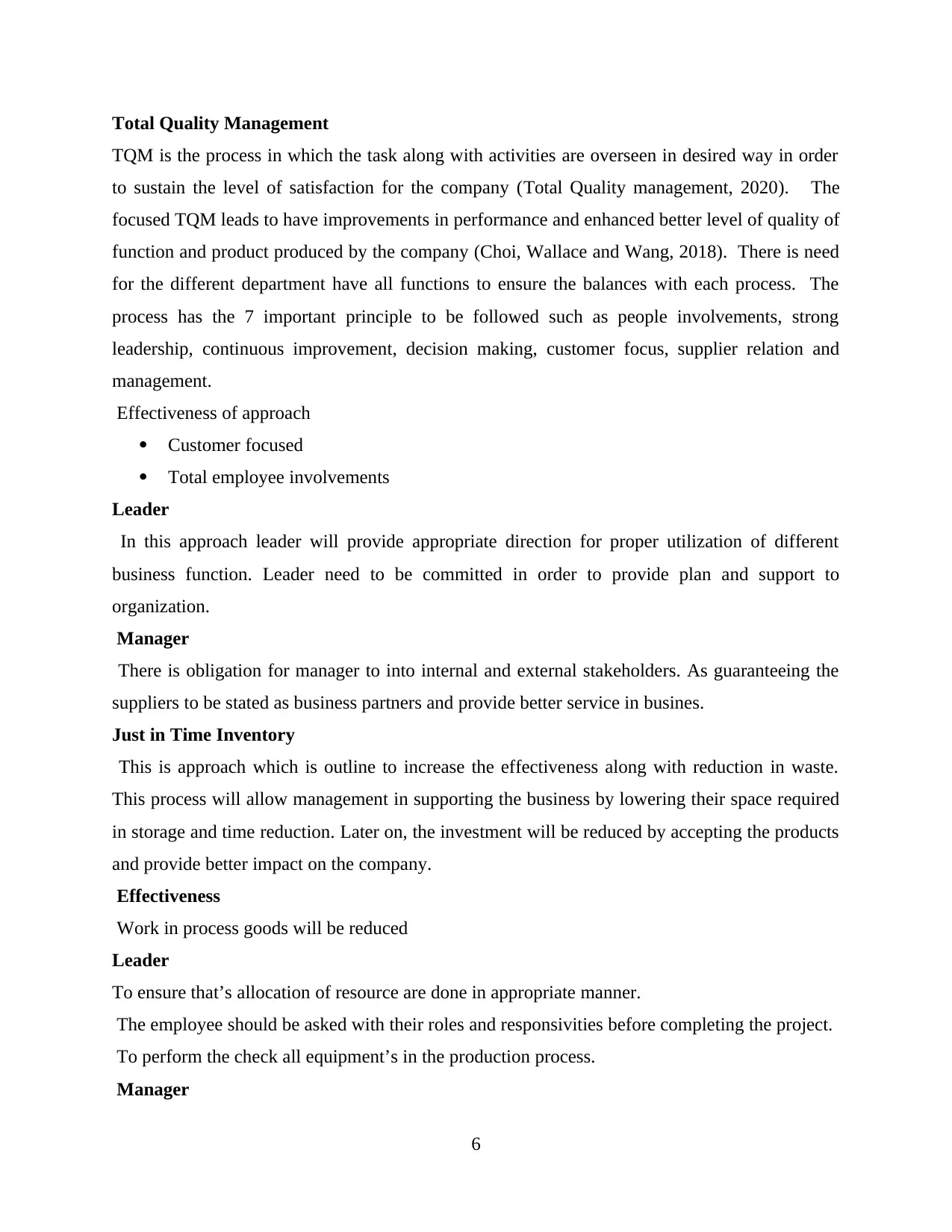
Total Quality Management
TQM is the process in which the task along with activities are overseen in desired way in order
to sustain the level of satisfaction for the company (Total Quality management, 2020). The
focused TQM leads to have improvements in performance and enhanced better level of quality of
function and product produced by the company (Choi, Wallace and Wang, 2018). There is need
for the different department have all functions to ensure the balances with each process. The
process has the 7 important principle to be followed such as people involvements, strong
leadership, continuous improvement, decision making, customer focus, supplier relation and
management.
Effectiveness of approach
Customer focused
Total employee involvements
Leader
In this approach leader will provide appropriate direction for proper utilization of different
business function. Leader need to be committed in order to provide plan and support to
organization.
Manager
There is obligation for manager to into internal and external stakeholders. As guaranteeing the
suppliers to be stated as business partners and provide better service in busines.
Just in Time Inventory
This is approach which is outline to increase the effectiveness along with reduction in waste.
This process will allow management in supporting the business by lowering their space required
in storage and time reduction. Later on, the investment will be reduced by accepting the products
and provide better impact on the company.
Effectiveness
Work in process goods will be reduced
Leader
To ensure that’s allocation of resource are done in appropriate manner.
The employee should be asked with their roles and responsivities before completing the project.
To perform the check all equipment’s in the production process.
Manager
6
TQM is the process in which the task along with activities are overseen in desired way in order
to sustain the level of satisfaction for the company (Total Quality management, 2020). The
focused TQM leads to have improvements in performance and enhanced better level of quality of
function and product produced by the company (Choi, Wallace and Wang, 2018). There is need
for the different department have all functions to ensure the balances with each process. The
process has the 7 important principle to be followed such as people involvements, strong
leadership, continuous improvement, decision making, customer focus, supplier relation and
management.
Effectiveness of approach
Customer focused
Total employee involvements
Leader
In this approach leader will provide appropriate direction for proper utilization of different
business function. Leader need to be committed in order to provide plan and support to
organization.
Manager
There is obligation for manager to into internal and external stakeholders. As guaranteeing the
suppliers to be stated as business partners and provide better service in busines.
Just in Time Inventory
This is approach which is outline to increase the effectiveness along with reduction in waste.
This process will allow management in supporting the business by lowering their space required
in storage and time reduction. Later on, the investment will be reduced by accepting the products
and provide better impact on the company.
Effectiveness
Work in process goods will be reduced
Leader
To ensure that’s allocation of resource are done in appropriate manner.
The employee should be asked with their roles and responsivities before completing the project.
To perform the check all equipment’s in the production process.
Manager
6
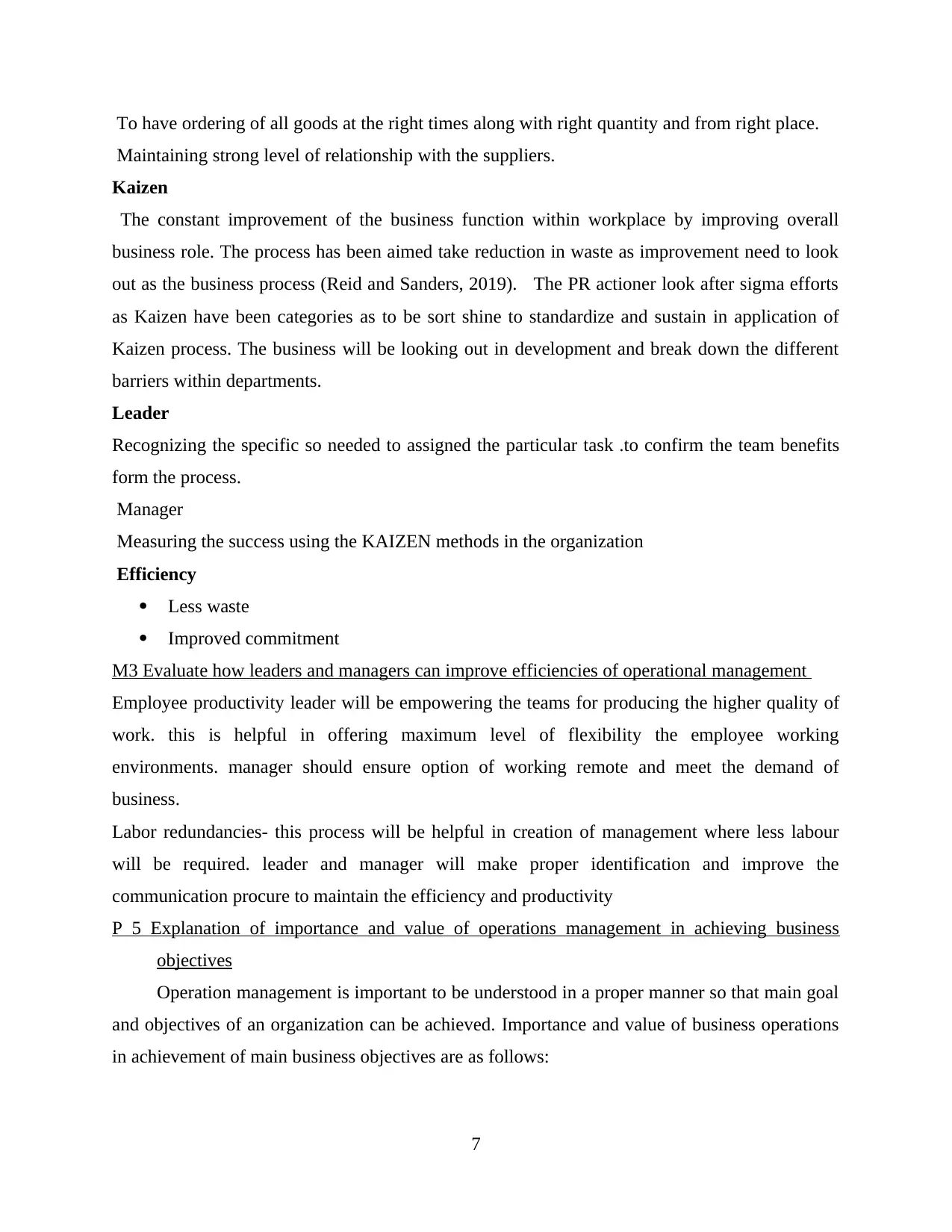
To have ordering of all goods at the right times along with right quantity and from right place.
Maintaining strong level of relationship with the suppliers.
Kaizen
The constant improvement of the business function within workplace by improving overall
business role. The process has been aimed take reduction in waste as improvement need to look
out as the business process (Reid and Sanders, 2019). The PR actioner look after sigma efforts
as Kaizen have been categories as to be sort shine to standardize and sustain in application of
Kaizen process. The business will be looking out in development and break down the different
barriers within departments.
Leader
Recognizing the specific so needed to assigned the particular task .to confirm the team benefits
form the process.
Manager
Measuring the success using the KAIZEN methods in the organization
Efficiency
Less waste
Improved commitment
M3 Evaluate how leaders and managers can improve efficiencies of operational management
Employee productivity leader will be empowering the teams for producing the higher quality of
work. this is helpful in offering maximum level of flexibility the employee working
environments. manager should ensure option of working remote and meet the demand of
business.
Labor redundancies- this process will be helpful in creation of management where less labour
will be required. leader and manager will make proper identification and improve the
communication procure to maintain the efficiency and productivity
P 5 Explanation of importance and value of operations management in achieving business
objectives
Operation management is important to be understood in a proper manner so that main goal
and objectives of an organization can be achieved. Importance and value of business operations
in achievement of main business objectives are as follows:
7
Maintaining strong level of relationship with the suppliers.
Kaizen
The constant improvement of the business function within workplace by improving overall
business role. The process has been aimed take reduction in waste as improvement need to look
out as the business process (Reid and Sanders, 2019). The PR actioner look after sigma efforts
as Kaizen have been categories as to be sort shine to standardize and sustain in application of
Kaizen process. The business will be looking out in development and break down the different
barriers within departments.
Leader
Recognizing the specific so needed to assigned the particular task .to confirm the team benefits
form the process.
Manager
Measuring the success using the KAIZEN methods in the organization
Efficiency
Less waste
Improved commitment
M3 Evaluate how leaders and managers can improve efficiencies of operational management
Employee productivity leader will be empowering the teams for producing the higher quality of
work. this is helpful in offering maximum level of flexibility the employee working
environments. manager should ensure option of working remote and meet the demand of
business.
Labor redundancies- this process will be helpful in creation of management where less labour
will be required. leader and manager will make proper identification and improve the
communication procure to maintain the efficiency and productivity
P 5 Explanation of importance and value of operations management in achieving business
objectives
Operation management is important to be understood in a proper manner so that main goal
and objectives of an organization can be achieved. Importance and value of business operations
in achievement of main business objectives are as follows:
7
⊘ This is a preview!⊘
Do you want full access?
Subscribe today to unlock all pages.

Trusted by 1+ million students worldwide
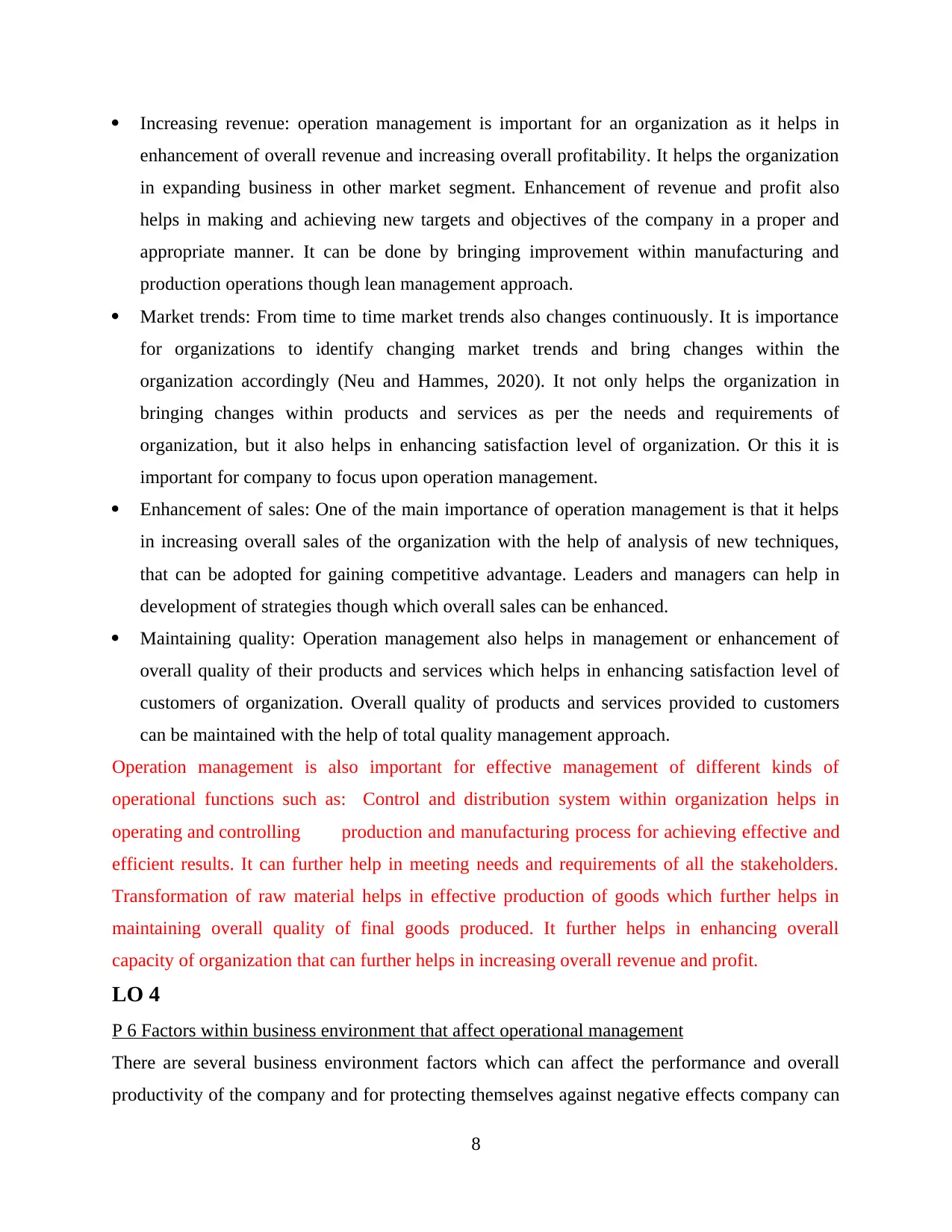
Increasing revenue: operation management is important for an organization as it helps in
enhancement of overall revenue and increasing overall profitability. It helps the organization
in expanding business in other market segment. Enhancement of revenue and profit also
helps in making and achieving new targets and objectives of the company in a proper and
appropriate manner. It can be done by bringing improvement within manufacturing and
production operations though lean management approach.
Market trends: From time to time market trends also changes continuously. It is importance
for organizations to identify changing market trends and bring changes within the
organization accordingly (Neu and Hammes, 2020). It not only helps the organization in
bringing changes within products and services as per the needs and requirements of
organization, but it also helps in enhancing satisfaction level of organization. Or this it is
important for company to focus upon operation management.
Enhancement of sales: One of the main importance of operation management is that it helps
in increasing overall sales of the organization with the help of analysis of new techniques,
that can be adopted for gaining competitive advantage. Leaders and managers can help in
development of strategies though which overall sales can be enhanced.
Maintaining quality: Operation management also helps in management or enhancement of
overall quality of their products and services which helps in enhancing satisfaction level of
customers of organization. Overall quality of products and services provided to customers
can be maintained with the help of total quality management approach.
Operation management is also important for effective management of different kinds of
operational functions such as: Control and distribution system within organization helps in
operating and controlling production and manufacturing process for achieving effective and
efficient results. It can further help in meeting needs and requirements of all the stakeholders.
Transformation of raw material helps in effective production of goods which further helps in
maintaining overall quality of final goods produced. It further helps in enhancing overall
capacity of organization that can further helps in increasing overall revenue and profit.
LO 4
P 6 Factors within business environment that affect operational management
There are several business environment factors which can affect the performance and overall
productivity of the company and for protecting themselves against negative effects company can
8
enhancement of overall revenue and increasing overall profitability. It helps the organization
in expanding business in other market segment. Enhancement of revenue and profit also
helps in making and achieving new targets and objectives of the company in a proper and
appropriate manner. It can be done by bringing improvement within manufacturing and
production operations though lean management approach.
Market trends: From time to time market trends also changes continuously. It is importance
for organizations to identify changing market trends and bring changes within the
organization accordingly (Neu and Hammes, 2020). It not only helps the organization in
bringing changes within products and services as per the needs and requirements of
organization, but it also helps in enhancing satisfaction level of organization. Or this it is
important for company to focus upon operation management.
Enhancement of sales: One of the main importance of operation management is that it helps
in increasing overall sales of the organization with the help of analysis of new techniques,
that can be adopted for gaining competitive advantage. Leaders and managers can help in
development of strategies though which overall sales can be enhanced.
Maintaining quality: Operation management also helps in management or enhancement of
overall quality of their products and services which helps in enhancing satisfaction level of
customers of organization. Overall quality of products and services provided to customers
can be maintained with the help of total quality management approach.
Operation management is also important for effective management of different kinds of
operational functions such as: Control and distribution system within organization helps in
operating and controlling production and manufacturing process for achieving effective and
efficient results. It can further help in meeting needs and requirements of all the stakeholders.
Transformation of raw material helps in effective production of goods which further helps in
maintaining overall quality of final goods produced. It further helps in enhancing overall
capacity of organization that can further helps in increasing overall revenue and profit.
LO 4
P 6 Factors within business environment that affect operational management
There are several business environment factors which can affect the performance and overall
productivity of the company and for protecting themselves against negative effects company can
8
Paraphrase This Document
Need a fresh take? Get an instant paraphrase of this document with our AI Paraphraser
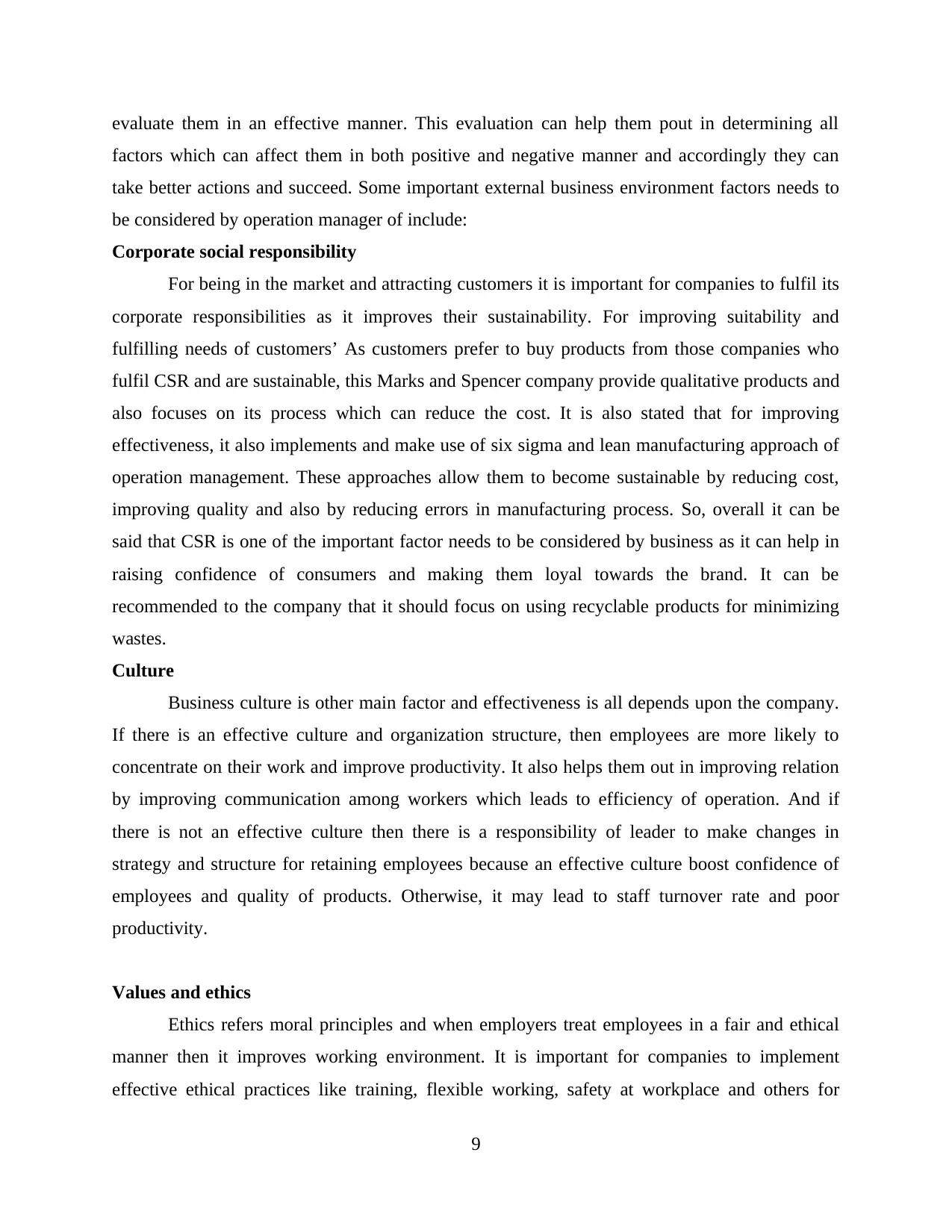
evaluate them in an effective manner. This evaluation can help them pout in determining all
factors which can affect them in both positive and negative manner and accordingly they can
take better actions and succeed. Some important external business environment factors needs to
be considered by operation manager of include:
Corporate social responsibility
For being in the market and attracting customers it is important for companies to fulfil its
corporate responsibilities as it improves their sustainability. For improving suitability and
fulfilling needs of customers’ As customers prefer to buy products from those companies who
fulfil CSR and are sustainable, this Marks and Spencer company provide qualitative products and
also focuses on its process which can reduce the cost. It is also stated that for improving
effectiveness, it also implements and make use of six sigma and lean manufacturing approach of
operation management. These approaches allow them to become sustainable by reducing cost,
improving quality and also by reducing errors in manufacturing process. So, overall it can be
said that CSR is one of the important factor needs to be considered by business as it can help in
raising confidence of consumers and making them loyal towards the brand. It can be
recommended to the company that it should focus on using recyclable products for minimizing
wastes.
Culture
Business culture is other main factor and effectiveness is all depends upon the company.
If there is an effective culture and organization structure, then employees are more likely to
concentrate on their work and improve productivity. It also helps them out in improving relation
by improving communication among workers which leads to efficiency of operation. And if
there is not an effective culture then there is a responsibility of leader to make changes in
strategy and structure for retaining employees because an effective culture boost confidence of
employees and quality of products. Otherwise, it may lead to staff turnover rate and poor
productivity.
Values and ethics
Ethics refers moral principles and when employers treat employees in a fair and ethical
manner then it improves working environment. It is important for companies to implement
effective ethical practices like training, flexible working, safety at workplace and others for
9
factors which can affect them in both positive and negative manner and accordingly they can
take better actions and succeed. Some important external business environment factors needs to
be considered by operation manager of include:
Corporate social responsibility
For being in the market and attracting customers it is important for companies to fulfil its
corporate responsibilities as it improves their sustainability. For improving suitability and
fulfilling needs of customers’ As customers prefer to buy products from those companies who
fulfil CSR and are sustainable, this Marks and Spencer company provide qualitative products and
also focuses on its process which can reduce the cost. It is also stated that for improving
effectiveness, it also implements and make use of six sigma and lean manufacturing approach of
operation management. These approaches allow them to become sustainable by reducing cost,
improving quality and also by reducing errors in manufacturing process. So, overall it can be
said that CSR is one of the important factor needs to be considered by business as it can help in
raising confidence of consumers and making them loyal towards the brand. It can be
recommended to the company that it should focus on using recyclable products for minimizing
wastes.
Culture
Business culture is other main factor and effectiveness is all depends upon the company.
If there is an effective culture and organization structure, then employees are more likely to
concentrate on their work and improve productivity. It also helps them out in improving relation
by improving communication among workers which leads to efficiency of operation. And if
there is not an effective culture then there is a responsibility of leader to make changes in
strategy and structure for retaining employees because an effective culture boost confidence of
employees and quality of products. Otherwise, it may lead to staff turnover rate and poor
productivity.
Values and ethics
Ethics refers moral principles and when employers treat employees in a fair and ethical
manner then it improves working environment. It is important for companies to implement
effective ethical practices like training, flexible working, safety at workplace and others for
9
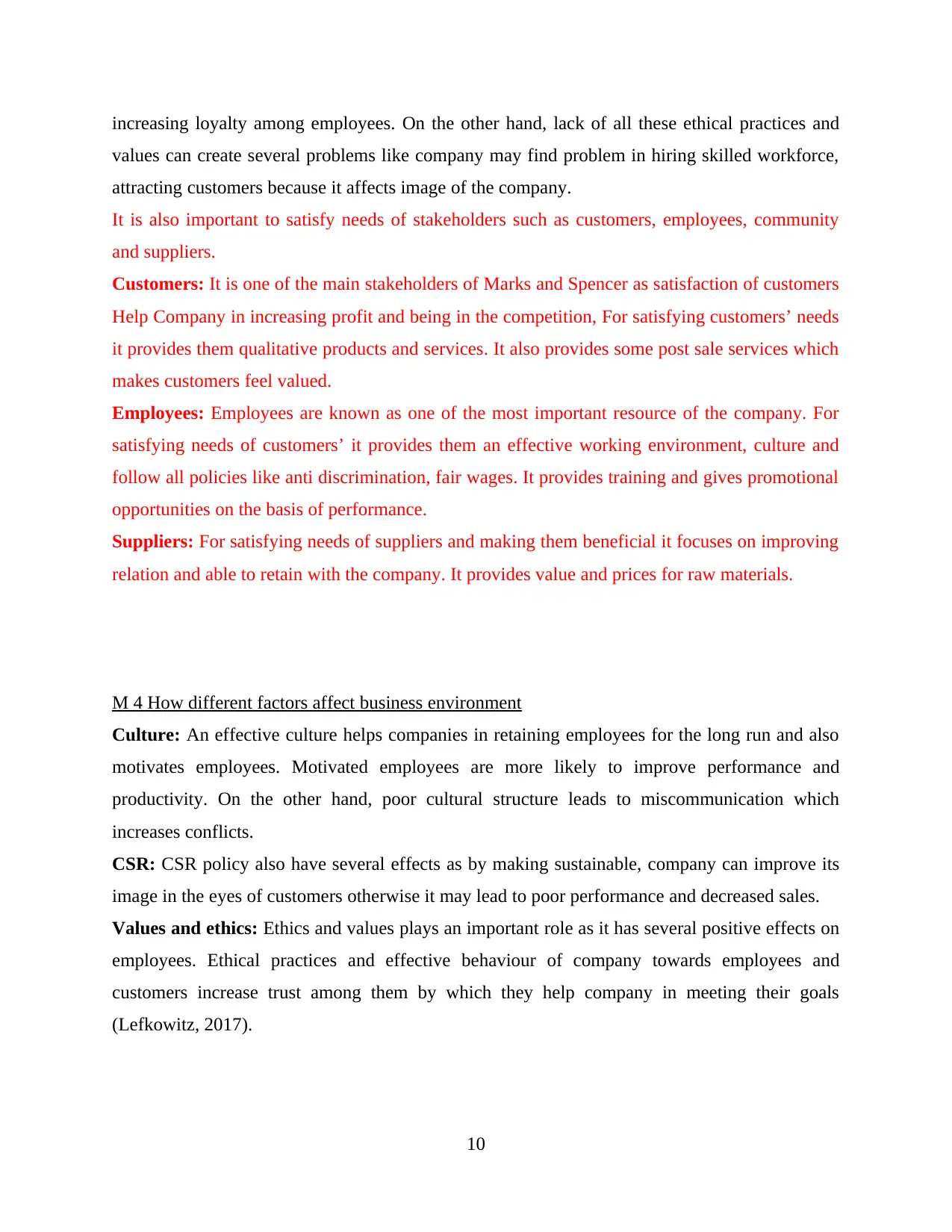
increasing loyalty among employees. On the other hand, lack of all these ethical practices and
values can create several problems like company may find problem in hiring skilled workforce,
attracting customers because it affects image of the company.
It is also important to satisfy needs of stakeholders such as customers, employees, community
and suppliers.
Customers: It is one of the main stakeholders of Marks and Spencer as satisfaction of customers
Help Company in increasing profit and being in the competition, For satisfying customers’ needs
it provides them qualitative products and services. It also provides some post sale services which
makes customers feel valued.
Employees: Employees are known as one of the most important resource of the company. For
satisfying needs of customers’ it provides them an effective working environment, culture and
follow all policies like anti discrimination, fair wages. It provides training and gives promotional
opportunities on the basis of performance.
Suppliers: For satisfying needs of suppliers and making them beneficial it focuses on improving
relation and able to retain with the company. It provides value and prices for raw materials.
M 4 How different factors affect business environment
Culture: An effective culture helps companies in retaining employees for the long run and also
motivates employees. Motivated employees are more likely to improve performance and
productivity. On the other hand, poor cultural structure leads to miscommunication which
increases conflicts.
CSR: CSR policy also have several effects as by making sustainable, company can improve its
image in the eyes of customers otherwise it may lead to poor performance and decreased sales.
Values and ethics: Ethics and values plays an important role as it has several positive effects on
employees. Ethical practices and effective behaviour of company towards employees and
customers increase trust among them by which they help company in meeting their goals
(Lefkowitz, 2017).
10
values can create several problems like company may find problem in hiring skilled workforce,
attracting customers because it affects image of the company.
It is also important to satisfy needs of stakeholders such as customers, employees, community
and suppliers.
Customers: It is one of the main stakeholders of Marks and Spencer as satisfaction of customers
Help Company in increasing profit and being in the competition, For satisfying customers’ needs
it provides them qualitative products and services. It also provides some post sale services which
makes customers feel valued.
Employees: Employees are known as one of the most important resource of the company. For
satisfying needs of customers’ it provides them an effective working environment, culture and
follow all policies like anti discrimination, fair wages. It provides training and gives promotional
opportunities on the basis of performance.
Suppliers: For satisfying needs of suppliers and making them beneficial it focuses on improving
relation and able to retain with the company. It provides value and prices for raw materials.
M 4 How different factors affect business environment
Culture: An effective culture helps companies in retaining employees for the long run and also
motivates employees. Motivated employees are more likely to improve performance and
productivity. On the other hand, poor cultural structure leads to miscommunication which
increases conflicts.
CSR: CSR policy also have several effects as by making sustainable, company can improve its
image in the eyes of customers otherwise it may lead to poor performance and decreased sales.
Values and ethics: Ethics and values plays an important role as it has several positive effects on
employees. Ethical practices and effective behaviour of company towards employees and
customers increase trust among them by which they help company in meeting their goals
(Lefkowitz, 2017).
10
⊘ This is a preview!⊘
Do you want full access?
Subscribe today to unlock all pages.

Trusted by 1+ million students worldwide
1 out of 14
Related Documents
Your All-in-One AI-Powered Toolkit for Academic Success.
+13062052269
info@desklib.com
Available 24*7 on WhatsApp / Email
![[object Object]](/_next/static/media/star-bottom.7253800d.svg)
Unlock your academic potential
Copyright © 2020–2025 A2Z Services. All Rights Reserved. Developed and managed by ZUCOL.





